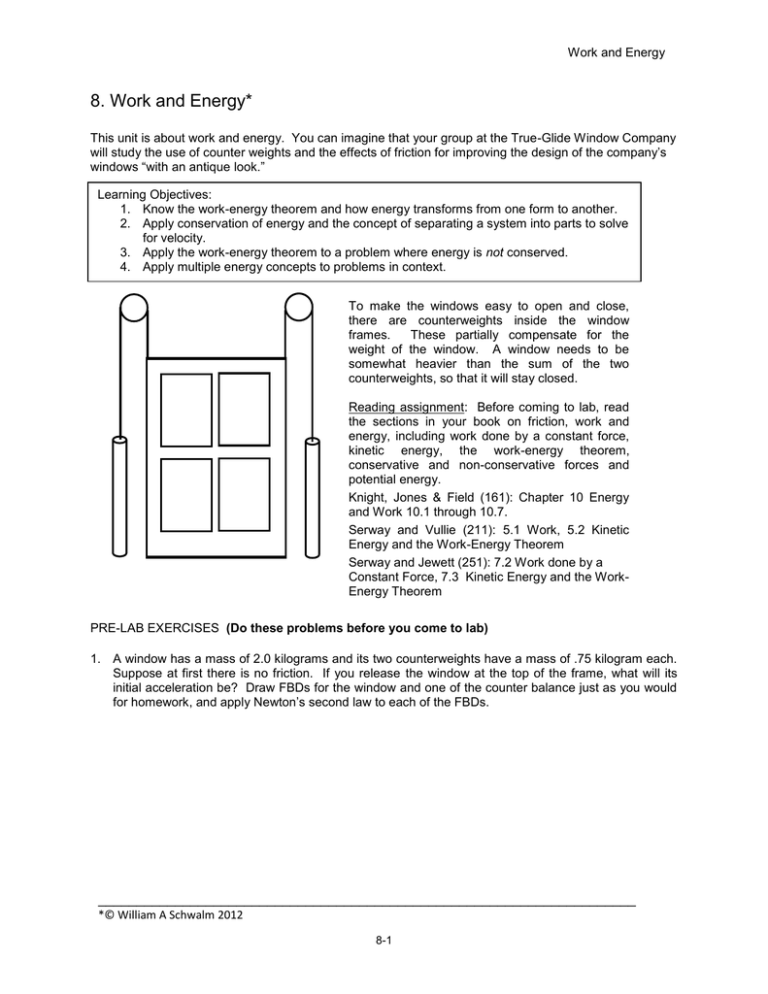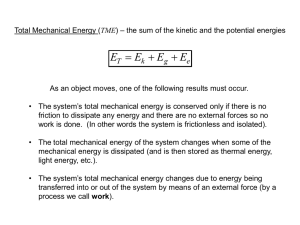8. Work and Energy*
advertisement

Work and Energy 8. Work and Energy* This unit is about work and energy. You can imagine that your group at the True-Glide Window Company will study the use of counter weights and the effects of friction for improving the design of the company’s windows “with an antique look.” Learning Objectives: 1. Know the work-energy theorem and how energy transforms from one form to another. 2. Apply conservation of energy and the concept of separating a system into parts to solve for velocity. 3. Apply the work-energy theorem to a problem where energy is not conserved. 4. Apply multiple energy concepts to problems in context. To make the windows easy to open and close, there are counterweights inside the window frames. These partially compensate for the weight of the window. A window needs to be somewhat heavier than the sum of the two counterweights, so that it will stay closed. Reading assignment: Before coming to lab, read the sections in your book on friction, work and energy, including work done by a constant force, kinetic energy, the work-energy theorem, conservative and non-conservative forces and potential energy. Knight, Jones & Field (161): Chapter 10 Energy and Work 10.1 through 10.7. Serway and Vullie (211): 5.1 Work, 5.2 Kinetic Energy and the Work-Energy Theorem Serway and Jewett (251): 7.2 Work done by a Constant Force, 7.3 Kinetic Energy and the WorkEnergy Theorem PRE-LAB EXERCISES (Do these problems before you come to lab) 1. A window has a mass of 2.0 kilograms and its two counterweights have a mass of .75 kilogram each. Suppose at first there is no friction. If you release the window at the top of the frame, what will its initial acceleration be? Draw FBDs for the window and one of the counter balance just as you would for homework, and apply Newton’s second law to each of the FBDs. ______________________________________________________________________ *© William A Schwalm 2012 8-1 Work and Energy 2. Still assuming no friction, if the window with counterweights attached were allowed to fall 25 cm (about 10 inches) from the top of the frame, how fast would it be moving when it hit the bottom sill? (Hint: what concept relates speed and position at one point to speed and position at another?) 3. In order to keep the window from falling the frame has to provide some friction (of course, not too much). a. Will the friction required be static friction or kinetic friction? b. How much frictional force is needed, at a minimum, and in what direction will it need to act on the window in order to just keep it from moving if you release it? 4. Now if the window did slip, a. How much frictional force would be needed to let it fall at a constant speed, and in what direction should this force act? b. Would this be static or kinetic friction? 8-2 Work and Energy 5. The Oxford University dangerous sports club invented the sport of bungee jumping. A jumper is attached to an anchor point at some great height by a strong, elastic bungee cord, and then jumps off into empty space for a long free fall. If all goes well, the un-stretched length of the cord is sufficiently less than the distance from the ground to the anchor point, so that the cord goes taught, stopping the jumper before he or she strikes the ground. An audacious physics student weighing 130 pounds attaches herself to the free end of a securely anchored bungee cord that is 110 feet long when un-stretched, and has a force constant of k = 540 Newtons/meter. Then she jumps from a bridge 150 feet above the floor of a canyon. Will she make it? What are the important safety considerations? Show your reasoning. Equipment: Two rod-mounted pulleys with various clamps, a tall vertical bar with bench mounting clamp, and a horizontal cross bar. There will also be a mass set, two-meter stick, a stopwatch and non-stretch string. Finally there will be an elastic shock cord or a supply of rubber bands. Problem 1 Your group needs to set up a laboratory model for the case of a window with counter weights and no friction. It is decided to use two pulleys and two unequal masses, as shown, and to measure velocities using a stopwatch and two-meter stick. The heavier weight can represent the window. 1. Method question: Neglecting friction, how best can work-energy ideas be used to find the speed of the heavier mass when it strikes the floor if it starts at rest from a known height? 1. Define each symbol you use. 8-3 Work and Energy What are unknowns? In order to find the velocity of the mass just hitting the floor what quantities in your equation you need to know? For each quantity listed above what quantities can you measure directly? What quantities you cannot measure? Draw FBD for each mass. 1. List two ways to express the final velocity. One you predicted and the other you measure using the stopwatch. 2. Prediction question: Suppose one mass is 210 grams and the other is 190 grams. If the heavier one starts from 1.5 meters above the floor, how fast should it be going when it reaches the floor? Explain your calculation. 3. Method question: How can the stopwatch and two-meter stick be used to measure final velocity, assuming the acceleration is constant? 8-4 Work and Energy Plan: Write a plan for your group’s measurement procedure. You need to say what the group members will do, what data will be taken and so on. How can you estimate the accuracy of your time measurements, for example? Implementation: Now make the distance and time measurements and record your data here. Make several of each measurement. Each group member should get a chance to measure. This way you can learn something about the accuracy. Analysis: Figure out the final velocity. Conclusions: What did you learn here? 1. What was the percent difference between the final speed you measured and what you predicted? 2. Based on your measurements, how much of the discrepancy could be due to friction and how much is probably accounted for by limits of accuracy in the measurements. (By now your group should be able to make quantitative statements about the accuracy in measuring time and distance.) And so, are you actually able to measure any frictional effects here? 8-5 Work and Energy Problem 2 Now consider sliding friction. There are several issues here. First in order to measure the coefficient of kinetic friction, you could set up a similar experiment using an apparatus like the one shown. 1. Method question: Give the standard friction model formula for kinetic friction and, starting from energy considerations, deduce a formula relating final speed of the falling weight when it hits the floor to the initial height, the masses, g and the coefficient of friction. Then, relate the distance fallen and the time to the coefficient of friction. Show the steps including algebra. 2. Prediction question: If the sliding block has mass 500 gm and the falling weight has mass 200 gm, how fast would the falling weight be going when it hit the floor if it started from 1.00 meters up and if the coefficient of sliding friction happened to be .25? 8-6 Work and Energy Plan: How would you use such a set-up to measure the coefficient of kinetic friction between two materials? Describe how the apparatus can be applied to make this measurement. What data would you need to have? How can you determine whether the data measurements are “repeatable” ? Implementation: Collect the necessary data and record it here, together with any necessary notes. Analysis: Use your data and the formula you got from the method question to determine the coefficient of friction between two wooden surfaces. Explain as appropriate. Conclusions: What did you learn? 1. Does this method seem to give a consistent, repeatable value for the coefficient of friction? 2. Can you estimate the accuracy? What things does the usual model of kinetic friction assume? For instance, does the frictional force depend on the speed? Would it depend on how large an area were in contact? How could you find out? 8-7 Work and Energy Problem 3 Bungee jump. Here your team from True-Glide is hired by the Dangerous Sports Club to model a bungee jump. The purpose is clear enough: The jumper doesn’t want to strike the ground. You want first to set up a laboratory model of the jump. The idea is to model the cord with rubber bands and the jumper with some fixed mass. 1. Method question: (a) Write down the usual formula for potential energy stored in a spring. (b) If you are going to use this for the rubber bands, how do you first measure a value for the force constant k ? 2. Prediction question: Suppose you had a rubber band with unstretched length of 10 cm and a force constant of k = 5 Newtons per cm. Then suppose you tied five of these end to end. Neglecting the size of the knots, what would be the unstretched length? What would be the new force constant K for the combination? (Hint: The same tension acts on each rubber band. How much does each one stretch?) 3. Prediction question: Given a model bungee cord of 50 cm length and force constant of 1.0 Newton per cm, suppose you model a jumper by a 100 gm mass. If the jumper jumps from the anchor point where the cord is tied, what is the maximum distance of descent down to where the taught bungee cord will stop the fall and the weight will start back up? Use energy considerations to do this and show your work. 8-8 Work and Energy Plan: Write here a plan for modeling a bungee jump. You need to say how to get the force constant. Then suppose a 200 gram weight is to jump from a platform and fall more than 150 cm but definitely less than 175 cm. You need to plan this jump, setting up a bungee cord of the proper length. Plan the jump here. Execute the plan: observed. Before you perform the jump, get your TA’s attention so that the jump can be Conclusions: Either the plan worked or it didn’t. If it did, what would you need to do to apply the idea to a real bungee jump? If it didn’t, what went wrong and what would you need to change? (By the way, in reality, some energy will be lost to heat, so energy is not quite conserved in the bungee jump. Will this be a good thing or a bad thing for the jumper? You should explain.) 8-9 Work and Energy 8-10




